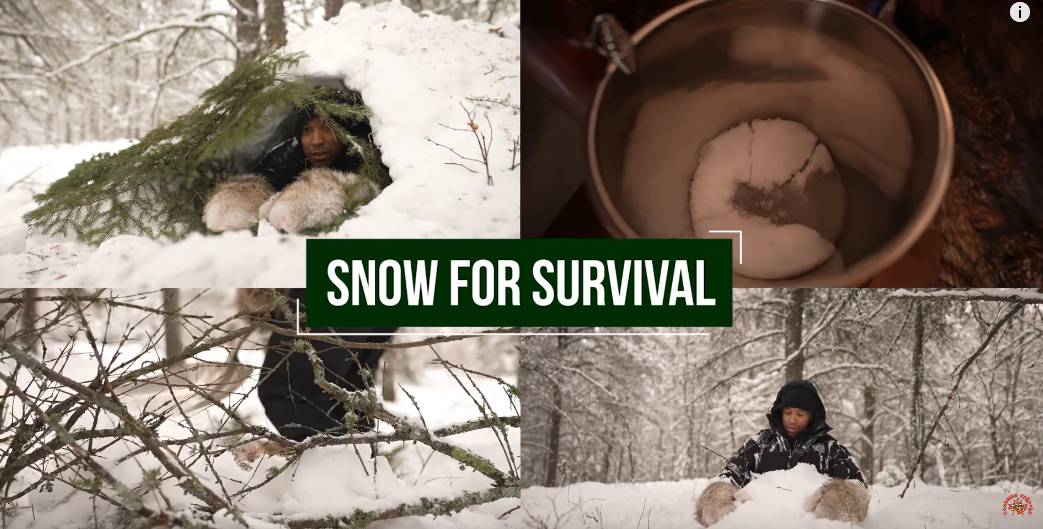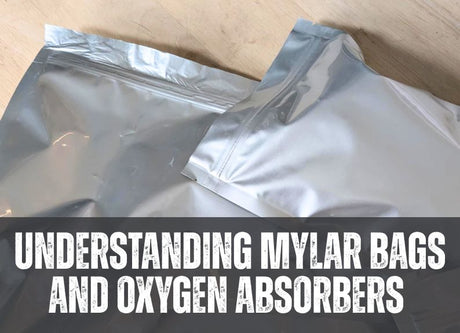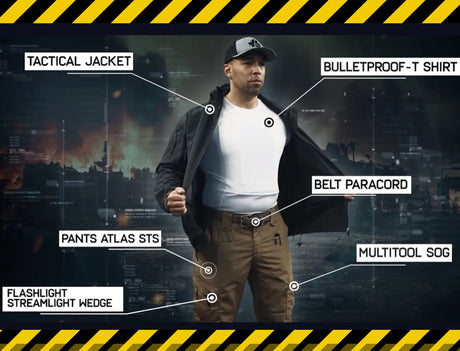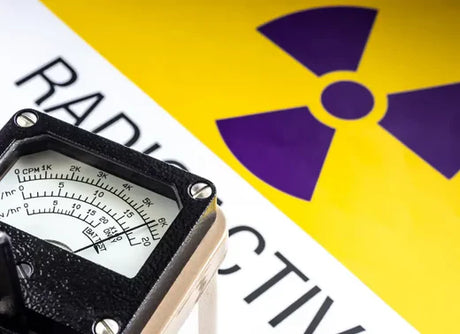In this blog, we go through the various uses of snow in survival settings. If your local environment is in the northern hemisphere, listen up and take notes. If you want to learn more, check out our youtube channel, where we demonstrate techniques and discuss survival scenarios.
Snow will provide shelter in winter survival scenarios.
When you’re left to the elements, snow can provide needed insulation and protection from the wind, helping you get warm and avoid hypothermia. In many places in the northern hemisphere, snowfall can be abundant for a significant portion of the year.
You can use snow as the main building material or help insulate your shelter from the elements. It seems conter-intuitive, but snow makes an excellent insulation material and can help keep you as warm as possible in an otherwise deadly environment.
3 Shelters you can build using snow.

-
Quinzhee
A quinzhee is one of the easier shelters to build, especially if you’re in an area where the snow isn’t deep enough to build other shelters, such as an igloo. These structures combine the elements of an igloo and a snow cave and can make decent temporary shelters when done correctly.
To build a quinzhee, first, gather as much snow as you can into a pile large enough in diameter for sleeping and minimal movement. Packing the snow down as you go, build your mound. When your mound is complete, mark several sticks of the same length and insert them into the mound; this will help to ensure that your walls are the same thickness all around, which will make your quinzhee more stable and safe. Begin to dig out the centre of your structure, ensuring you find the edge of each inserted stick. When complete, dig a vent hold in the top of the quinzhee for ventilation, so you don’t suffocate in your new accommodations.
-
Igloo
If the snow is just right you should be able to cut blocks and use them to build an igloo structure. An igloo is one of the most innovative and structurally sound ways to escape the elements and will be able to provide significant warmth from just your body heat alone.
To make the perfect igloo, you will need a lot of snow that is densely packed. Typically, this is the kind of snow where you can walk without falling through––powdery snow will not be easily carved or manipulated.
Start your build by creating a circle; typical igloos are about 7 feet in diameter; you can ensure you create a perfect circle by attaching a 3.5’ piece of rope or paracord to a stick and moving in a circle. The first circle of building blocks will come from within this circle, so ensure you choose a building site on the snow-ice needed to build your structure. Cut each block to form a ramp that starts from ground level and increases incrementally with each block. Start on the following rows when you have the row complete, but cut them, so they slowly lean into the centre as you go. Fill the gaps with snow as you go to eliminate gaps and keep the structure sound. When you have completed your dome, fashion a door as well as a ventilation hole for fresh air.
-
Snow trench
If you find yourself in a desolate landscape with limited resources for shelter, a snow trench can provide a quick 1-2 man shelter from the cold. The same snow that can be used for making an igloo is perfect for the trench. Dig down and then build a roof from snow-ice blocks, or use any available bows with insulating snow as a roof. While this is not a long-term solution, it can provide temporary protection while building a more permanent structure.
Snow provides a source of clean water for cooking and drinking.
Snow is condensation, but it will take more snow to fill a pot for boiling than you assume. We recommend keeping a 10:1 ratio in mind, ten parts snow for one part water. When you use snow for water, you will still need to clean it. Parasites, debris, and other harmful substances exist, even in snow. At a minimum, you should be boiling, and, if available, you can put it through additional filtration––depending on the source. To learn more about purifying water, you can read our blog on clean water or check out our Youtube channel for more.

Warming the snow into water will help prevent your body from burning unnecessary calories when they are few and far between. In addition, if you’re calorie deficient, you can threaten to enter thermogenesis, a process where your body burns calories in an attempt to keep you warm. Thermogenesis will eventually lead to hypothermia, one of the top killers of people exposed to the elements.
Snow makes it easier to identify animal tracks.
If you know what tracks to look for, you can easily identify species roaming in the area you have chosen for bugging out. When you rely on hunting to help you survive in the bush, finding animal runs and common feeding areas for animals can cut down the effort needed to find food––hunt smarter, not harder.
![]()
For survival, set no fewer than two dozen traps. While you might have the right bait and everything set properly, it is still a game of calculated chance. Never rely on one trap to sustain yourself––that’s a great way to starve. Check your traps daily to ensure your catch is fresh and not eaten by another creature first. Never put your bare hands in the snare line once the trap is set, or risk losing skin or a digit.
In the wild, animals are incredibly clever. You can use an enzyme spray to eliminate your scent or utilize your own handmade charcoal powder to ‘clean’ the area and tools. Be conscious that everything you touch will leave a tell-tale scent that will signal danger to your potential lunch.
Know and understand the trapping laws in your local region. While some traps are designed for bushcraft emergency survival only, owning these traps can be seen as a direct violation of the gaming laws in your area.
3 bushcraft traps you can set with limited supplies
What you will need:
-
Snare
Snares come in a wide range of styles, but they all form off of a fundamental setup. Trigger lines, snare line, and bait. Whether you choose a Graves’ bait stick snare, peg snare, fixed snare, or drowning snare, there are several available styles that can fit your needs and skill level. The number one way to ensure that trapping is fruitful for you post-collapse is to practice techniques ahead of time.
-
Deadfalls
A deadfall trap perches a deadly weight atop of a triggered system. The secret to a successful deadfall trap is to have the weight fall fast enough from the trigger to trap and kill the animal you’re hunting. There are many styles, including the figure-four deadfall, the Paiute deadfall, or the challenging but extremely effective McPherson spring deadfall.
Learn the location of large game by understanding their movement habits
When tracking larger games, your biggest advantage is understanding which tracks belong to which animal. In the winter, tracking is considerably easier as the footprints are readily available to even an inexperienced eye. When food is scarce, animals that graze will frequent areas where the snow is soft and allows them to break through to the vegetation beneath. This can be an advantage to a hunter. Understanding trails and frequent feeding and drinking locations will cut down on wasted effort and give you a higher chance of finding your lunch.
In the winter, large game can be hauled by a solo hunter with the use of a toboggan. One of the best ways to thrive is to be prepared to use your local environment to your advantage.
Use snow to conceal yourself in dangerous environments.
If you’re in an area where you need to hide quickly and effectively, snow can come to your advantage. While you may lose body heat more quickly, it is a potentially useful way to hide if you are being tracked or are in danger. However, you cannot effectively hide your footprints, so be sure to be careful and disturb your environment as little as possible.

As a preventative measure, you can surround your shelter or tent with snow to help conceal your location as much as possible. This will also help to keep your tent insulated from the cold as well as prevent your tent from being torn away in a harsh winter storm.
Snow can be an effective tool in personal and medical care.
Snow is just really cold water, after all. If you need toilet paper in a pinch, you can make an effective but chilly wipeout of a good snowball. While it’s not going to be comfortable, it will be effective.
In addition, you can use a snowball as an effective but chilly way to clean your body, wash a wound, clean your hands, or treat an injury. However, ensure that you have a warm shelter and fire roaring before you subject yourself directly to a cold snowball. Avoiding thermogenesis and subsequent hypothermia should be your number one goal.
In an emergency, you will have to use what you have. Snow can also numb and freeze an area or wound that you need to suture or drain when you do not have access to pain killers or freezing. Numb the area with clean snow or ice to help offset the pain.
Reflect heat using snow around your firepit.
Build up a reflective wall of snow on the opposite side of the fire as your shelter to direct heat in your direction as well as prevent the wind from decimating your fire. To do this, use wood and other deadfall to build a barrier that you can easily cover in snow. Ensure that you pack the snow down so that it isn’t easily blown over by the elements. Build your barrier far enough from the fire that it won't immediately melt and drown your only source of warmth, but close enough that it is an effective barrier from the wind.
Knowing your environment can help you survive anything.
When you are familiar with where you live and practice surviving in the elements, you will be more prepared for an emergency or societal collapse. Don’t just read about how to survive; get out and learn to winter camp with your friends and family. We have the right tools to help build your survival repertoire.










